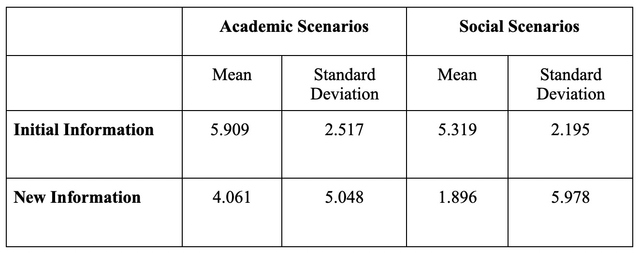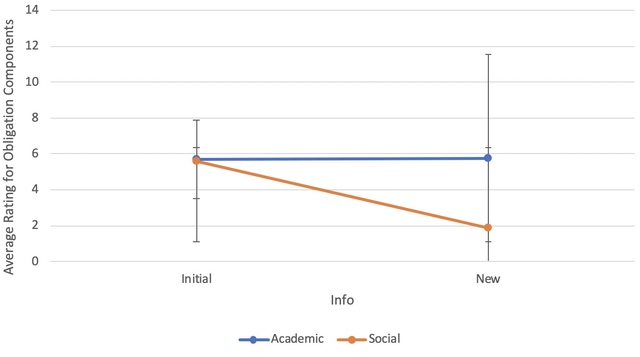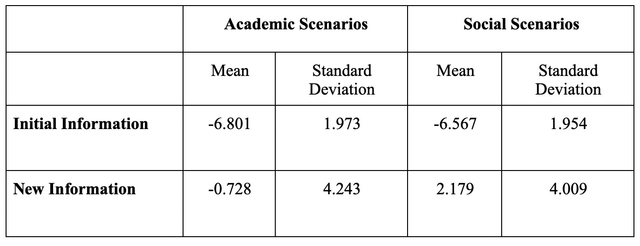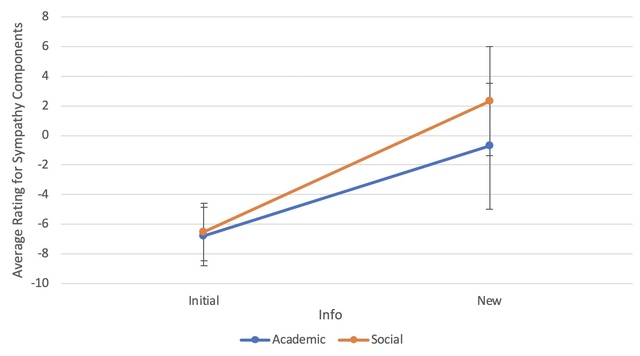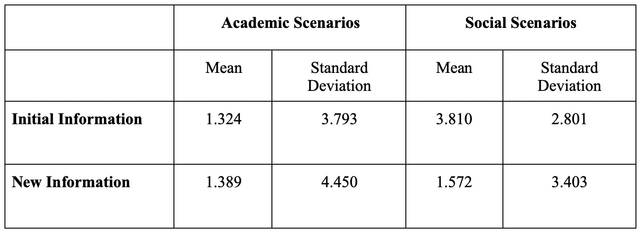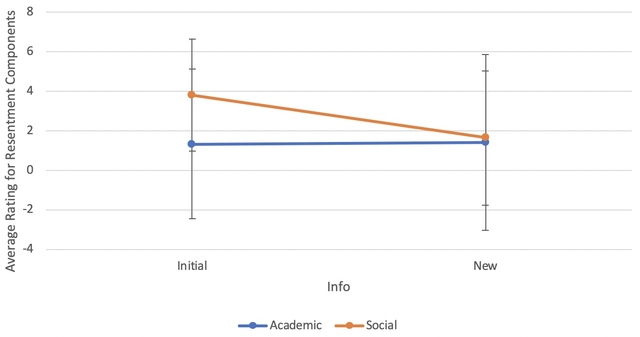The Weight of Emotions on Decision-Making: A Comparative Analysis
By
2020, Vol. 12 No. 09 | pg. 1/1
IN THIS ARTICLE
KEYWORDS
AbstractWhen making decisions, a person must rationally analyze their options and understand potential outcomes. Emotions, the way that we feel in a particular moment, are also involved in how we respond to others. But how much do emotions really weigh upon our ability to form decisions? There is a possibility that emotional factors can be considered from a rational or emotional perspective in decision-making. Therefore, a person's decision-making process has the potential to produce different outcomes. In the current study, 57 participants (ages 18 to 23) completed a survey where they were required to form decisions about 8 academic and 8 social scenarios. After an initial decision regarding each scenario, participants were given more context to the situation that might change the rating of their decision. A comparison was made between participants’ initial responses and their responses after being provided with additional context. It was determined that participants responded more rationally to academic scenarios than to social scenarios. When presented with an academic scenario and an obligation component, participants responded more emotionally than if they received an academic scenario and sympathy component. It was also determined that students responded more rationally to each initial academic and social scenario and more emotionally to the resentment components that followed both types of scenarios. Ultimately, decision–making was found to be heavily impacted by emotion along with being affected by the context of the situation in the moment. Decision-making involves many components that allow a person to evaluate their choices and come to the most optimal and beneficial decision (Saaty, 2008). Decisions are made after detailed consideration of what is required, as well as the logical aspect and emotional factors involved. This process is conscious, effortful and controllable, but is nevertheless influenced by emotions (Reniers, Corcoran, Völlm, Mashru, Howard, & Liddle, 2012). Academic decisions can be affected by one’s motivation to succeed and their drive for success. A person may feel that those around them feel the same way, and that the common goal is to succeed together. Social decisions can be influenced by beliefs about ourselves and our desires, rather than the state of the other person.Regardless, both academic and social decisions require thoughtful processing and a certain level of understanding of the situation. There are two approaches to decision-making. The first approach, the rational choice model of decision-making, assumes that decision makers know enough relevant information about their environments to rationally evaluate their choices and come to a conclusion (Bruch & Feinberg, 2017). This gives people the opportunity to process alternative explanations and come to a rational and determinative conclusion of their own accord. When a person begins the decision-making process, they realize that many factors must be accounted for in order to determine whether they need to take a rational approach or an emotional approach.There are four factors that influence the amount of rationality given to a decision. These factors are information, time constraints,relevance, and commitment. The four factors influence how rational the decision will be and whether the person will choose an option most beneficial to themselves or others. First, decisions require information that will help a person evaluate their circumstances and come to a well-thought-out conclusion (Pfister and Böhm 2008). People often use heuristics, or shortcuts, in decision-making; but heuristics do not look at all the information presented in a situation. Therefore, the accuracy of a decision made with heuristics is lower. In order to fulfil this first requirement of rational decision-making, one must carefully analyze the context of the situation in order to reduce the possibility of a faulty decision (Gigerenzer & Gaissmaier, 2011). Second, decisions require time constraints. In real life, the pressure of time is a major factor in decision making and can influence a person to sway towards one choice rather than another option (Pfister & Böhm 2008). When a person is given a deadline for when they need to have formed a decision, they think in a quicker and more direct manner. They can only go through a certain number of alternative outcomes in order to reach their decision. The third and fourth factors are relevance and commitment. Decisions require that a person determine if the information presented is truly relevant to the situation (Pfister and Böhm, 2008). The perspective from which the situation is looked at determines whether the information provided will be deemed necessary to form a decision or if it is considered extraneous. Not all information benefits our decision-making process, and some information can cloud our ability to judge the relevance of other information (Saaty, 2008). Generally, with decision making, a person can only have small pieces of information added or they will feel overwhelmed and not come to the decision they truly prefer (Bruch & Feinberg, 2017). Therefore, a person needs to quickly determine how relevant different information is in their decision-making process. Decisions also require the ability to commit and implement the decision going forward. More often, people commit to decisions that concern their social and moral values (Pfister & Böhm, 2008). When people make decisions that require intense processing of external factors, they prefer not to change their preference and they remain committed to the decision. However, decisions sometimes are made before receiving all pertinent information regarding a situation; once someone receives more context for a personal request, can they be induced to change their opinion? The first approach to decision-making states that decision makers are able to come to a rational decision by evaluating their options, looking at the context and other relevant information.On the other hand, the second approach to decision-making says that decision making is influenced by emotional perspectives which have the potential to create antagonistic feelings or ambivalence, which make decision-making difficult (Pfister & Böhm, 2008). Ambivalence makes the decision-making process more difficult by causing a person to feel internally conflicted. People can form thoughtful decisions more easily when they do not feel conflicted about which belief should dominate their thinking process. In order to come to a decision, emotions are considered, as well as other “random” pieces of information that may not initially seem as impactful on the decision but hold great importance. When the emotional mechanisms of decision-making become effortful, cognitive systems are able to assist in quickly and efficiently forming a decision (Garcés & Finkel, 2019). Both approaches allow a person to form a decision but from different perspectives. In addition to the components of rationality, emotional mechanisms also contribute to the decision-making process. Emotion is not a homogenous category but is a word used to refer to many different categories (Pfister & Böhm, 2008). This means that emotion is a multi-faceted combination of different feelings and states of being. Furthermore, people form positive and negative associations with different emotions (Bruch & Feinberg, 2017), therefore allowing different emotions to have a greater or lesser role in the decision-making process based on the person. The involvement of emotions in decision-making does not deter a person from the normal path to forming a decision as previously believed. Rather, emotions are the main system that we initially use to process information and form an optimal decision (Garcés & Finkel, 2019). Decisions involving an emotion lead the decision maker down a pathway of considering the effect on themselves and less of the effect on another person. Humans are selfish beings for thinking this way, and this method can be harmful in the long run if a person always and only chooses themself over others. When we fully understand the intentions, emotions, and beliefs of others, we are able to make successful decisions (Frith & Singer, 2008) with which we are satisfied. Emotions allow for the selective regulation and inhibition of additional cognitive processes in decision-making (Garcés & Finkel, 2019). We often hear about the difficulties people encounter when trying to reach a rational decision while feeling intense emotions such as anger. An emotion is seen as a feeling that we are experiencing in a moment; in some situations, we can experience multiple emotions and feel conflicted. Complex emotions are contextual states of mind, and depending on the context, might be positive, negative or both” (Pfister & Böhm, 2008). Currently, there are academic articles that exist on decision–making in social situations, social cognition in the formation of conclusions, and the multidimensionality of emotions. Yet, there have not been many studies testing the true weight of emotions on decision-making in social contexts, as well as in other situations. Therefore, I decided to choose three interpersonal emotional factors (obligation, sympathy, and resentment) that I felt could motivate a person to form specific decisions depending on the context. Obligation, sympathy, and resentment are three interpersonal social emotions that can influence a person’s decision in a different way than basic emotions such as happiness, sadness, and anger. With basic emotions, a person’s mood is directly affected and may cause them to sway one way or another in forming a decision. In addition, the basic emotions can be visibly noticed through facial expressions (Anonymous, 2012). Interpersonal social emotions are not visibly noticeable and are influenced by a person’s internal thoughts and thought processes (Anonymous, 2012). More thinking and consideration must go into the determination of a decision due to interpersonal social emotions. Therefore, this category of emotions have an indirect effect because it is situational and depends on personal interpretation. Decision-makers form decisions where their beliefs and values will be respected (Pfister & Böhm, 2008). This motivated me to look at the impact of moral obligation on the decision-making process. I wanted to observe if a person would continue to commit to a decision they believe is right, or if they could be influenced to change their mind. When a decision concerns someone else, decision-makers may take into consideration the feelings of others (Reniers, et al., 2012). This influenced me to look at the effect of sympathy on decision-makers. I wanted to determine whether a person would be motivated to help someone if they felt a strong sense of pity for them. Decision-makers are more willing to help someone if they feel sympathetic or empathetic towards them or if they feel that they owe a person a favor (obligation). This inspired me to look at if feelings of animosity from resentment could influence a person against helping their friend. Therefore, obligation, sympathy, and resentment are three interpersonal social emotions that have the potential to affect our decision-making process. Obligation is an emotional component that motivates a person to help someone as they feel they owe the person. A person may feel influenced to come to a decision out of a strong desire to help others and they may overlook the chance to benefit themselves. When a person feels bound by guilt, they may also experience a greater motivation to help another person. They will feel that they owe the person a favor due to past assistance and will have a hard time denying a request. This motivation does not aim for the selfish side of a person, rather it aims for the creation of a decision out of selflessness. Obligation can also be looked at in terms of personality quality, and agreeableness.People who are friendlier are more likely to think well of people (Organ, Podsakoff, & MacKenzie, 2006) and help others when they recognize an unfulfilled need. With an obligation component, a student may feel driven to make a decision based on the fact that another person made a sacrifice previously for them. Sympathy is another emotional component that can cause a person to think unselfishly and make a decision that favors another person over themselves. Certain factors may influence a person to feel more deeply for someone, and to make a decision using their sympathetic and/or empathetic side rather than using obligation or resentment. In order for this component to have an effect, the pros of the decision that may benefit someone have to be greater than the decision that prioritizes our personal desires. Empathy allows us to understand the emotions and sensations of others and this helps us connect with others when we make decisions (Frith & Singer, 2008). Therefore, the role of sympathy in decision-making influences us to think unselfishly and to form decisions that may benefit others. Emotional stability is an important motivator in the ability of sympathy to influence a person (Organ, Podsakoff, & MacKenzie, 2006). When people feel stable enough to take the problems of others into consideration, they are more responsive to components such as obligation and sympathy. These two components have the potential to lead to similar decisions but with different motivations. Resentment is the third emotional component and it may influence a person to act selfishly in an attempt to optimize their profits. They may choose to self-rationalize their behavior rather than just doing the right thing. As an example, consider a situation where a business owner hires a manager to work at his satellite office. If the manager is sneaky and cheats the business owner, he would receive $1,500 and the owner would lose $500.If the manager is honest, then he and the owner both receive $1,000. The manager may feel obligated not to cheat due to receiving the position and feeling grateful towards the owner, therefore both parties would benefit. If the manager feels any inclination of resentment towards the owner, he may cheat, and this harms the owner, and in the long run, harms himself as well (Pfister & Böhm, 2008). This leads back to the point previously made that humans have a potential to think selfishly and make decisions that only benefit themselves rather than themselves and others. Unlike obligation, it appears that resentment causes humans to make decisions that are based on selfishness. But does this always occur? In this study, I have decided to observe the impact of three emotional factors: obligation, resentment, and sympathy on a previously formed decision, and whether they can influence a person to rethink that decision. I would like to know whether a person will feel that these emotional factors influence them to use rationality or emotion in their decision-making process. In addition, it would be interesting to determine whether students attribute similar weight to academic and social situations or whether they are looked at differently. In order to test my hypotheses, participants will receive a scenario in which they are required to make a decision. They will have to determine how much they feel their decision was emotionally or rationally influenced. Depending on their initial response and rating, they will be presented with an additional piece of information targeting either the emotion of obligation, resentment, or sympathy. They will be asked to confirm their decision or change it. Then they will again state whether their decision was rationally or emotionally determined. I hypothesize that the initial rating on the Rational-Emotional Scale will differ between the academic and social scenarios. I hypothesize that the ratings will differ between the obligation and sympathy components for academic scenarios. I also hypothesize that the ratings for the social scenarios due to the sympathy components will be more rational than the ratings for the obligation components. This is because the person will have to take into consideration their situation and whether they can afford to help another person, without putting themselves at risk. I hypothesize that there will be a difference between a student's initial ratings for the academic and social scenarios, and their ratings after being presented with the resentment statements. This would be due to resentment creating a feeling of animosity in an individual causing them to respond more emotionally regarding another person. I also hypothesize that more students will believe their decision for both types of scenarios with the resentment component was rationally based rather than emotionally based. I assume that students will describe their decision as rational as they will feel spited by their friend. This will lead them to rationalize why they are not helping their friend. Each hypothesis has their own question and will be analyzed individually to determine their effect on and relationship with decision-making. MethodologyParticipantsFifty-seven participants aged 18 to 23 years (M = 19.228, SD = 1.225) participated in the study. These students were recruited from Hofstra University’s Spring 2020 PSY 001 classes. Forty-four participants were females and thirteen participants were male. No participant data was excluded. MaterialsA survey was created in order to test whether participants’ initial decisions could be changed by an additional piece of information. Participants were presented with 16 scenarios where they were required to form decisions regarding a close friend. For each scenario, participants responded with yes or no and rated how rational or emotional their decision was. They rated their decision on a scale of -10 to +10. A very rational rating would be -10, while a very emotional rating would be +10, and 0 would be neutral. If participants responded yes, then they were given the resentment component as the additional information. If participants responded no and gave a rating of less than or equal to zero, then they were presented the sympathy component next.If participants responded no and gave a rating of greater than zero, they were presented with the obligation component next. Participants then were able to change their initial decision if they desired, and they again rated how rational or emotional their decision was. Then participants completed a short demographic survey.Participants were able to access the link for the survey through the Sona System and they completed the survey online through the Qualtrics survey site. The survey could be taken on a computer or cellphone. ProcedureSurvey Data Collection After clicking the link for the survey, the participant gave their consent to participating. They completed a sample scenario in order to understand the structure of the survey scenarios. Participants were instructed to think of a good friend but not a best friend while making the decisions. They were told that they would make a decision regarding a friend and would have to decide whether the decision was more rationally or emotionally determined. Depending on their initial answer, they would be presented with one type of additional information and would have the opportunity to change or keep their answer. Following this, they would again determine whether their decision was based on rationality or emotion. Data Analysis Three 2X2 within-subjects ANOVAs were performed to test for main effects and interactions for each of the three obligation components based on context and information. Paired t-tests were performed comparing the variables that participants responded to. These variables included their initial answer and initial rating to the scenario, as well as their answer and rating to the obligation, sympathy, and resentment components. ResultsPercent change in yes responses for emotional components in academic and social scenarios The following values describe the percent change in yes responses for each emotional component under academic scenarios. The obligation components had a 24% decrease in yes responses, the sympathy components had a 15% increase, and the resentment components had a 69% decrease. The following values describe the percent change in yes responses for each emotional component under social scenarios. The obligation components had a 12% decrease in yes responses, the sympathy components had a 30% increase, and the resentment components had a 74% decrease. Is there an effect of context, information, or both on the decisions made when presented with an obligation component? A 2 (context: academic versus social) x 2 (information: initial versus new) within-groups ANOVA was performed to determine whether the ratings for the obligation component differed based on the context or the information presented. The dependent measure was the ratings on the Rational-Emotional scale. There was evidence of a significant main effect of context on the ratings for obligation components (F (1,19) = 5.858, p = 0.026). For the obligation component, participants rated academic scenarios more emotionally than the social scenarios. There was evidence of a significant main effect of information on the ratings for obligation components (F (1,19) = 6.161, p = 0.023). Participants rated the initial information as more emotional than the new information. There was evidence of a significant interaction between context and information, (F (1,19) = 10.169, p = 0.005). The results are shown in Figure 1 below. Post-hoc tests confirm that participants only significantly changed their rating for social scenarios (t (23) = 3.043, p = 0.006) and not for academic scenarios (t (32) = 1.986, p = 0.056) when given new information that suggests obligation. Therefore, the interaction was driven by the change in ratings for the social scenarios. The means and standard deviations are shown in Table 1 below. Table 1. Averages and Standard Deviations for Academic and Social Scenarios with Initial and New Information Regarding the Obligation Component Figure 1. Average rating on the Rational-Emotional scale for the initial academic obligation scenarios, new academic obligation scenarios, initial social obligation scenarios, and new social obligation scenarios. Is there an effect of context, information, or both on the decisions made when presented with a sympathy component? A 2 (context: academic versus social) x 2 (information: initial versus new) within-groups ANOVA was performed to determine whether the ratings for the sympathy component differed based on the context or the information presented. The dependent measure was the ratings on the Rational-Emotional scale. There was evidence of a significant main effect of context on the ratings for sympathy components (F (1,54) = 20.672, p<0.001). Participants rated academic scenarios more rationally than the social scenarios. There was evidence of a significant main effect of information on the ratings for sympathy components (F (1,54) = 234.584, p<0.001). Participants rated the initial scenarios as more rational than the new ones. There was evidence of a significant interaction between context and information, (F (1,54) = 17.924, p<0.001). The results are shown in Figure 2 below. Post-hoc tests confirm that participants significantly changed their rating for both academic scenarios (t (54) = -10.084, p<0.001) and social scenarios (t (56) = -15.179, p<0.001) when given new information that suggests sympathy. The change in ratings for the social scenarios was greater than the change in ratings for the academic scenarios. Thus, the interaction was driven by the change in ratings for social scenarios. The means and standard deviations are shown in Table 2 below. Table 2. Averages and Standard Deviations for Academic and Social Scenarios with Initial and New Information Regarding the Sympathy Component Figure 2. Average rating on the Rational-Emotional scale for the initial academic sympathy scenarios, new academic sympathy scenarios, initial social sympathy scenarios, and new social sympathy scenarios. Is there an effect of context, information, or both on the decisions made when presented with a resentment component? A 2 (context: academic versus social) x 2 (information: initial versus new) within-groups ANOVA was performed to determine whether the ratings for the resentment component differed based on the context or the information presented. The dependent measure was the ratings on the Rational-Emotional scale. There was evidence of a significant main effect of context on the ratings for resentment components (F (1,55) = 12.121, p = 0.001). Participants rated academic scenarios less emotionally than the social scenarios. There was evidence of a significant main effect of information on the ratings for resentment components (F (1,55) = 5.918, p = 0.018). There were differences between the initial and new statements for both academic and social scenarios. There was evidence of a significant interaction between context and information, (F (1,55) = 9.025, p = 0.004). The results are shown in Figure 3 below. Post-hoc tests confirm that participants only significantly changed their rating for social scenarios (t (56) = 4.306, p < 0.001) and not for academic scenarios (t (55) = -0.106, p = 0.916) when given new information that suggests resentment. Therefore, the interaction was driven by the change in ratings for social scenarios. The means and standard deviation are shown in Table 3 below. Table 3. Averages and Standard Deviations for Academic and Social Scenarios with Initial and New Information Regarding the Resentment Component Figure 3. Average rating on the Rational-Emotional scale for the initial academic resentment scenarios, new academic resentment scenarios, initial social resentment scenarios, and new social resentment scenarios. Are there differences in initial ratings of academic and social scenarios based on context? A paired t-test was performed to determine whether the rating on the Rational-Emotional scale differed between academic and social scenarios. The average initial rating on the Rational-Emotional scale for academic scenarios was more rational (M = -1.884, SD = 2.661) than the rating for the social scenarios (M = -0.331, SD = 1.838). There was a significant difference between the ratings, (t (56) = -5.833, p < 0.001). Are there differences between the ratings for obligation and sympathy components in academic scenarios? A paired t-test was used to determine whether the rating on the Rational-Emotional Scale differed between the obligation and sympathy components for academic scenarios. The average rating on the Rational-Emotional scale for the obligation components of the academic scenarios was more emotional (M = 4.00, SD = 5.116) than the ratings for the sympathy components (M = -0.918, SD = 4.477). There was a significant difference between the ratings (t (31) = 3.954, p < 0.001). Are there differences between the ratings for obligation and sympathy components in social scenarios? A paired t-test was used to determine whether the ratings for the social scenarios that included sympathy components would be more rational than the ratings for the obligation components. The average rating on the Rational-Emotional scale for the obligation components of the social scenarios was 1.896 (SD = 5.978), while the rating for the sympathy components was 2.045 (SD = 3.555). There was no significant difference between the ratings (t (23) = -0.103, p = 0.919). Are there differences between the initial ratings for academic and social scenarios and the new ratings for resentment components for both of these scenarios? A paired t-test was performed to determine whether there was a difference between a student’s initial rating for the academic scenario and their rating on the resentment components. The average initial rating on the Rational-Emotional scale for the academic scenarios was more rational (M = -1.823, SD = 2.649) than the rating for the resentment components (M = 1.389, SD = 4.450). There was a significantdifference between the ratings (t (55) = -5.653, p < 0.001). A paired t-test was performed to determine whether there was a difference between a student’s initial rating for the social scenarios and their rating on the resentment components. The average initial rating on the Rational-Emotional scale for the social scenarios was more rational (M = -0.331, SD = 1.838) in contrast to the resentment components (M = 1.573, SD = 3.403). There was a significant difference between the ratings (t (56) = -4.101, p < 0.001). Discussion & ConclusionIn this study, participants had the option to use rationality or emotion in the decisions they made. The process of using rationality can also be called the “theory of mind.” This theory allows us to understand beliefs or wishes in others (Frith & Singer, 2008) and take them into consideration when making a decision. Emotion plays a different role as a person will have to take how they feel and their state of being into consideration when coming to a decision. There were multiple goals of the study. These included looking for differences in how students responded to academic versus social scenarios and looking for differences in responses to emotional components within the scenarios. It is often easier to make a decision regarding oneself than to make a decision involving another person. But it becomes challenging when a person feels motivated to make a certain decision despite their own circumstances. In terms of obligation, a person may feel influenced to help someone due to feeling guilty since they owe their friend a favor. With sympathy, a person feels motivated to help someone due to feeling sorry for them or feeling pity for them. With resentment, a person may feel less inclined to help their friend because they may be holding a grudge due to lack of support. The first element that was individually analyzed was obligation. I was able to conclude that the effect of context on the ratings for the obligation component differed based on the information presented. When students received academic scenarios, they rated their decision from the initial obligation information as less emotionally based than their decision with the new obligation information. When students were presented with social scenarios, they rated their decision from the initial obligation information as more emotionally based than their decision with the new obligation information. Although evidence supported the interaction, the ratings for the initial and new information did not differ for academic scenarios while the ratings differed for the social scenarios. The ratings for the obligation components differed based on the context where academic scenarios were rated more emotionally than social scenarios. The ratings for the obligation components also differed based on the information presented where participants overall rated the initial information more emotionally than the new information. Many factors must be taken into consideration in order to come to a truly optimal and beneficial decision (Saaty, 2008). One factor is context. Academics as a whole are often held in high regard; initially students respond to obligation components emotionally. With the new information, the response was still emotional, but they now had more context and would feel that it would be on them if their friend did not succeed. Therefore, the person responded more emotionally. Academics were looked at in the same light regardless of whether one felt obligated to do something or not. Social decisions are often made using one’s intuition as they may involve a preference. When a person feels forced to do an activity, they will see it less emotionally and begin to rationally consider alternative options. Therefore, the rating for the new information was much less emotional than the rating for the initial information. Social scenarios were looked at differently potentially due to a person truly considering whether they would want to do an activity they did not like, and whether it was worth it to return the favor. Next, the emotional component, sympathy, was looked at in terms of context and information. The effect of context on the ratings for the sympathy components demonstrated differences based on the information presented. When students received academic scenarios or social scenarios, they rated the initial information more rationally than the new information. There were differences between the ratings for the initial and new information for both academic and social scenarios. The ratings for the sympathy components differed based on the context where participants rated academic scenarios more rationally than the social scenarios. The ratings for the sympathy components also differed based on the information presented where participants rated their decisions from the initial scenarios as more rational than the decisions from the new information. Regardless of the situation, when a person recognizes an urgent need in another person, they often feel motivated to help alleviate the person’s stress. A person will rationally consider the needs of someone else and analyze the potential outcomes if they did not help. They will have to look at the level of disruption to their lives if they helped their friend. Emotional stability (Organ, Podsakoff, & MacKenzie, 2006) also plays a role because if a person lacked stability in their decision-making process, they would almost always use intuition when making a decision. Doing this would cause them to overlook the potential negative impact that the decision may have on themselves. With academic and social scenarios, the initial information was very rationally considered in the creation of a decision. When the new information was presented, the ratings shifted, and the decisions were more emotionally rated. The ratings shifted the most for the social scenarios where they were fully emotional. Participants most likely felt pity for their friend and were more willing to assist them as needed. Helping their friend in a social situation provided less of a chance to affect the person negatively and therefore one could emotionally react. Lastly, the resentment component was analyzed. The effect of context on the ratings for the resentment components demonstrated differences based on the information presented. Students rated the initial information as less emotional than the new information when given academic scenarios. Students rated the initial information as more emotional than the new information when given social scenarios. There were differences between the ratings for the initial and new information for social scenarios but not for academic scenarios. The ratings for the resentment components differed based on the context where participants rated academic scenarios less emotionally than the social scenarios. The ratings for the resentment components also differed based on the information presented where participants rated their decisions from the initial scenarios as more emotional than the decisions from the new information. When presented with a resentment statement, students initially reacted emotionally as they had been wronged by their friend and felt less inclined to help them. With academic scenarios, the person responds even more emotionally to new information, possibly because their success is affected, and they feel less of a desire to help their friend. On the other hand, with social scenarios, the person responded less emotionally to new information. This may be due to the person thinking through their options and feeling that it is not worth their time to feel upset over the situation. It was predicted that there was a difference between participants' initial ratings to academic and social scenarios. The ratings differed between the two variables and the hypothesis was supported. Participants considered their initial responses to the academic scenarios to be more rational than their responses to the social scenarios. Academics are often looked at as a gateway to success and one’s future success can be determined by their ability to do well in school. Participants may feel that anything that may impact their academic success, negatively or positively, must be carefully considered from all aspects. This would cause participants to respond more rationally to the academic scenarios. Socially, people often tend to make decisions based on what they are feeling in the moment, and this would be an emotional decision. A person may form a decision based off of the morals and values that they hold. This takes concentration and great effort (Reniers et al., 2012). With the initial scenarios for both categories, a person’s friend’s true intentions and previous actions are not known yet. Therefore, the person can only decide whether to help their friend based on if they have the time to do so and if they have the right resources. Furthermore, the amount of pressure a person puts on themselves to form a decision must also be considered. If a person feels constrained by time in making a decision (Pfister and Böhm, 2008), or feels that the decision is an easy one, they may use their emotional perspective, such as with the social scenarios. If the person feels that a decision will take more consideration and additional information, they may be cautious and use their rational side as with academic scenarios. It was predicted that there would be a difference between the rating of the obligation and sympathy components for academic scenarios. The ratings differed between the two components and the hypothesis was supported. Participants considered their response to the obligation component to be more emotional than their response to the sympathy component. It was noticed that the response to the sympathy components were slightly rational. Although both components were looked at from an academic perspective (which was initially considered rational), they were rated differently. A person may rationally think through their options when making an academic decision as it involves their personal success, but they may go with a more instinctive feeling when making a social decision, as it often involves fun. Despite this, when an additional component is added, the participant is forced to reanalyze their initial decision, and the decision has the potential for change depending on the initial level of commitment (Pfister and Böhm, 2008). With complex decisions, a person may lean towards doing what is right even if it takes away their ability to make a decision that is best for themself (Pfister and Böhm, 2008). With obligation, a person may feel a strong desire to help their friend due to what their friend has previously done for them. This may cause them to feel that they have no other choice but to help and they would make an emotionally based decision. Obligation can also be looked at in terms of knowledge (Dvoskin, 2002). Knowing someone’s situation and understanding why they are requesting assistance, provides valuable information that allows a person to consider whether to help or not. On the other hand, when a person is presented with a sympathy component in an academic situation, they may feel the need to assist, as they realize their friend may be desperate for help. In this situation, a person would feel that the success of their friend depends on what decision they make. Therefore, they may rationally look at the additional information and feel better helping their friend as it might be seen as the morally right decision. They would choose this over feeling guilty that they did not help, and that their friend did not succeed. It was predicted that participants’ ratings for the social scenarios due to the sympathy components would be more rational than the ratings for the obligation components. The ratings for both components were both emotional, did not differ, and the hypothesis was not supported. In general, participants tended to rate academic scenarios as more rational than social scenarios. Regardless of whether participants felt coerced into helping their friend, or felt pity and helped, they valued any information relating to the social scenarios on a similar level. With the sympathy components, people have an ability to empathize with others (Frith & Singer, 2008), and therefore would feel very emotionally inclined to respond a certain way. With the obligation components, if a friend had previously participated in a social activity with an individual, then they may feel slightly inclined to do something for them. In both cases, this “emotional twinge” caused participants to form a decision using their emotional perspective. People have an ability to share the emotions of others (Frith & Singer, 2008), and when they feel that they can help someone without being negatively impacted, they are more willing to assist as they can. People often participate in social activities with others that they care about, but what if there is no true benefit to themselves? Participants were more likely to form a decision with both obligation and sympathy components using intuition rather than rationalizing through all of their options. This could be due to the fact that the social scenarios provided did not have a detrimental effect on anyone’s success and therefore did not require a high level of cognitive processing. Decisions often have multiple attributes (Bruch & Feinberg, 2017) but it is possible that the two components did not add a layer of complexity to the initial scenario. Therefore, participants did not see a need to think of alternative outcomes. This allowed participants to come to a decision quickly using their emotional side in order to assist their friend, and therefore, no difference was seen between the components. It was expected that students’ initial ratings on the academic scenarios and on the social scenarios would differ from their ratings after being presented with the resentment statements. For the academic scenarios, the ratings for the initial scenarios were more rational than the ratings for the resentment components. For the social scenarios, the ratings for the initial scenarios were also more rational than the ratings for the resentment components. Therefore, the hypothesis was supported. It is often easy for a person to develop resentment towards another person. When a person hurts someone, how much that other person is affected, can depend on the type of relationship between the two people. When a person forms a grudge, they may be likely to respond harshly to others or even cut off friends. This can occur even when there may be a misunderstanding about the situation. The participants were more inclined to analyze wrongdoings from an emotional perspective despite the situation and did not see a need to rationally analyze what was done to them. When it comes to a decision with a resentment component, a person may use their emotional perspective to form a decision and respond in a less helpful way. Regardless of whether a scenario was academic or social, participants valued both situations the same way, as they were hurt by their friend, felt less of a need to help them, and reacted emotionally. People are less inclined to look at situations through the lenses of others, and they will assume that others view a situation the same way that they do (Frith and Singer, 2008). Then when a person does something unexpected, they are highly offended, and the experience takes more of a toll on them. A person’s reaction due to resentment affects their decision–making process on a greater level and can also lead to a more emotional decision. It was predicted that for both scenarios, students would rate their responses to the resentment component as more rationally based than emotionally based. There were differences between the initial ratings and the ratings for the resentment components for both scenarios, but this hypothesis was not supported. This was because the ratings for the resentment statements were more emotionally based than rationally based. Emotions are sometimes looked at as a facet that hinders peoples’ ability to form the best decision (Pfister & Böhm, 2008). This is not always true, as without certain emotions, people may be taken advantage of, or mistreated. If a person did not react to someone doing wrong to them and continued to help them, it might negatively affect themselves in the long run. With the resentment component, people did not rationalize how they felt regarding their friend. They chose to respond in a way that would make them feel that they had made the right decision. The resentment component demonstrates that a person’s emotions can be quickly affected (Dricu & Frühholz, 2019) and cause them to perceive a situation negatively. When upset, people do not always stop to think why something was done or said. They ignore additional factors that could alter their decision. Information that should be considered (Pfister & Böhm, 2008) may not be seen as important. The person will choose to act or say something and may not realize the impact of their words in the moment. They overlook the ultimate consequences of their decision for the sole purpose of benefiting themselves. When a person despises another, they may respond faster and in a way that would hinder the success or progress of another person. With these reasons, it is likely that a person would respond in a more emotional manner after being offended by what their friend has done. Decision – making is considered to be a rational process that involves the consideration of multiple factors such as information, relevance, and time constraints. If decision – making only involved looking at the logical side of the situation, then the rationality of the process may be affected (Pfister & Böhm, 2008). In addition, decisions formed differ based on the context and situation (Dricu & Frühholz, 2019). Emotions are a valuable factor that also influence the decision – making process and allow us to analyze the decision from alternative perspectives. Emotions influence our ability to look at situations rationally and form optimal choices that can benefit others and ourselves. Without emotions, there is a lower chance of forming an optimal decision. In sum, rationality and emotion hold varying importance in the decision-making process and play a valuable role in the formation of decisions that can lead to our success as well as the success of others. There were a few limitations of this study. Time constraints affect a person’s ability to form a decision and may cause the person to use their intuition rather than rationally analyzing all options available (Pfister and Böhm, 2008). Participants were told that the survey would take about 30 minutes, but they were not timed while participating. There were no time constraints, and this may have allowed participants to feel more relaxed while taking the survey, therefore causing them to respond differently. In addition, participants took the study in different locations due to unforeseen circumstances, which caused the location to be unstandardized between participants. Participants also may have been experiencing different emotions such as anger, stress, or anxiety prior to beginning the survey and this may have altered the responses provided.Participants were told to rate how rationally or emotionally based their decision was, but in certain situations it is difficult to determine this. A person could rate their decision rationally but may be slightly influenced by the interpersonal social emotion. Therefore, the study was slightly limited by an inability to determine whether participants had accurately rated their decision. One major strength of the study was the within-subjects design which required less participants as all participants went through every scenario. This design also allowed for a comparison of the three emotional components to a neutral baseline for each participant (Eimontaite, Nicolle, Schindler, & Goel, 2013). There are many directions that future research can go in. It may be valuable to test whether giving participants a specific amount of time for each decision, would cause them to rate their decision as more rational or emotional. It would also be interesting to test whether ratings would strongly favor rationality or emotion due to other emotional components such as disgust, envy, jealousy, or hatred. In addition, participants were told to think of a good friend while taking the survey, but it is possible that they would have responded differently if the person were a best friend, acquaintance, or significant other. The survey could be given again, and participants could be told to think of a different person while making decisions. Participants could also watch a neutral video before beginning the survey in order to neutralize their emotions. This way, there would be the potential for a greater impact of the different emotional components on their decision–making process. It could be looked into whether other scenario environments (such as church, work, family life) would see a difference in the ratings and responses to different emotional components. It would be interesting to see if the emotional factors would have different effects depending on the situations. Lastly, comparisons could also be made to see whether the emotional factors have different effects based on gender. ReferencesAnonymous (2012). “6.3 Emotions and Interpersonal Communication.” A Primer on Communication Studies, 1.0, pp. 355–365. Bruch, E., and Feinberg, F. (2017). Decision-Making Processes in Social Contexts. Annual Review of Sociology, 43(1), 207–227. doi: 10.1146/annurev-soc-060116-053622 Dricu, M., and Frühholz, S. (2019). A neurocognitive model of perceptual decision-making on emotional signals. Human Brain Mapping 41(6). https://doi-org.ezproxy.hofstra.edu/10.1002/hbm.24893 Dvoskin, J.A. (2002). Knowledge is Not Power-Knowledge is Obligation. Journal of the American Academy of Psychiatry and the Law 33, 533-540. Eimontaite, I., Nicolle, A., Schindler, I., and Goel, V. (2013). The effect of partner-directed emotion in social exchange decision-making. Frontiers in Psychology 4(469). doi: 10.3389/fpsyg.2013.00469 Frith, C. D., and Singer, T. (2008). The role of social cognition in decision making. PubMed Central, 363(1511), 3875–3886. doi: 10.1098/rstb.2008.0156 Garcés, M., and Finkel, L. (2019). Emotional Theory of Rationality. Frontiers in Integrative Neuroscience 13(11). doi: 10.3389/fnint.2019.00011. Gigerenzer, G., and Gaissmaier, W. (2011). Heuristic Decision Making. Annual Review of Psychology 62, 451-482. doi: 10.1146/annurev-psych-120709-145346. Organ, D. W., Podsakoff, P. M., and MacKenzie, S. B. (2006). Organizational Citizenship Behavior. Thousand Oaks, California: Sage Publications, Inc., 81-82 Pfister, H.-R., and Böhm, G. (2008). The multiplicity of emotions: A framework of emotional functions in decision making. Judgment and Decision Making, 3(1), 5–17. Retrieved from http://journal.sjdm.org/bb1.pdf Reniers, R. L. E. P., Corcoran, R., Völlm, B. A., Mashru, A., Howard, R., and Liddle, P. F. (2012). Moral decision-making, ToM, empathy and the default mode network. Biological Psychology, 90(3), 202–210. https://doi.org/10.1016/j.biopsycho.2012.03.009 Saaty, T.L. (2008). Decision making with the analytic hierarchy process. International Journal of Services Sciences 1(1), 83-98. AppendixPart 1. Survey with Three Emotional Components Academic Scenarios: (a) is obligation, (b) is resentment, (c) is sympathy 1.) Your friend asks to copy your homework 30 minutes before it is due. Would you give it to them? a. Remember, they helped you write a 6-page paper last week. b. This is last minute, and you don’t appreciate more stress added to you. Would you still help? c. They have a family member in the hospital, and they are stressed. Would you still help? 2.) Your friend wants to cheat off of your test in class, but the teacher is always watching. Would you let them? a. Remember that your friend wrote half of your paper for you when you had a lot going on. b. Your friend is lazy and never studies. Do you still want to help? c. Your friend has test anxiety and really needs a good grade to boost their average. Do you still help? 3.) Your friend asks you to do volunteer research in finance when your major is psychology. Would you do it? a. Remember, your friend did psychology research with you last semester when their major is finance. Would you do it? b. Your friend constantly forgets that you need to work to afford tuition and don’t have time for many extracurriculars. Would you make time to do it? c. Your friend really needs another person to apply with them or they won’t be able to do the research. Would you help them? 4.) Your friend wants you to join an academic club with them, but it conflicts with your schedule. Do you rearrange your schedule to join? a. Remember that your friend joined a club with you last semester, even though they had to stay on campus an extra two hours after their class finished. Do you join? b. Your friend told you that your favorite club is trash. Would you still join? c. Your friend is very shy and won’t go unless you go. Would you go? 5.) Your friend wants you to do a semester-long project with them, but you know you’ll end up doing all the work. Do you agree to work together? a. Remember that your friend covered for you in class when you didn’t know the answer to a question. Do you work with them? b. Your friend is very lazy and usually ends up telling you that you should do all the work even if they initially agree to help. Do you still work with them? c. Your friend takes care of their four siblings after class and works a part time job, you know it is likely you will end up doing a majority of the work. Do you help? 6.) Your friend wants you to go to office hours with them for an assignment, but the professor is rude to you. Would you go? a. Remember your friend spent 2 hours with you at a review session last week. Would you go? b. Your friend ignored you when you asked them to come with you to office hours for another professor. Would you still want to go? c. The professor is rude to your friend as well, but you are braver than your friend to meet the professor. Do you still go? 7.) Your friend wants you to join a Mon-Wed-Fri class with them when most of your classes are Tue-Thur. Do you register for the class? a. Remember, your friend switched into your class last semester two weeks late because you didn’t know anyone else and felt lonely. Would you join the class? b. Your friend switched out of your class after 2 weeks even though they promising to study with you for the semester. Would you still join the class? c. Your friend has no other friends in the class and is very shy. Would you join the class? 8.) Your friend receives a bad grade in a class and asks what your grade was. You did better than them. Do you tell them your grade? a. Remember that your friend didn’t tell you their grade when you received a bad grade in the class. Do you tell them your grade? b. Your friend likes to brag about their grades all the time. Do you still tell them? c. Your friend is devastated by their grade, would you still tell them? Social Scenarios: (a) for obligation, (b) for resentment, (c) for sympathy 1. Your friend asks to borrow your car on a school night. Would you let them? a. Remember they let you borrow their car for a weekend trip. Would you let them use the car? b. They did not let you borrow their car when yours broke down and you needed to get to work. Would you still lend them the car? c. Their family member is very sick, and your friend needs to get to the hospital quickly to see them before it’s too late. Would you lend them the car? 2. Your friend is going to a party at 1 am, and they invite you to go with them 2 hours prior. Would you go? a. Remember, they picked you up from the library at 3 am the other night when they had class at 7 am. Would you go with them? b. When your friend parties, they end up intoxicated and say rude things to you. Would you still go? c. Your friend is a shy person, and this is their first party. Would you go with them? 3. Your friend wants you to go to a concert with them in a different state, but you hate the performers. Would you go? a. Remember, your friend went with you to a 5- hour math tournament before. Would you go? b. Your friend said your taste in music is awful and they didn’t come with you to see your favorite performers. Would you still go with them? c. Your friend is nervous about traveling alone. Would you go with them? 4. Your friend wants to go on a double date, but you don’t know the other person. Would you go? a. Remember, your friend went on a double date with you last month. Would you go? b. Your friend said something crazy about you in front of your crush previously and you were rejected. Would you still go? c. You have a significant other, but your friend has been wanting to date this person for 5 years and this may be their only chance. Would you go? 5. Your friend invites you to a big party at 11 pm but you are very busy. Would you go? a. Remember, you have a test tomorrow. Would you go? b. Your friend only invites you when they want a ride home. Other than that, they never want to hang with you. Would you still go? c. Your friend has been sick for 2 years and is finally feeling better. They want to have fun. Do you go with them? 6. Your friend wants to sleep over at your dorm for a night. Would you let them stay over? a. Remember, your friend fought their strict parents for you to stay at their house for a month when you did not have the money to pay for your dorm, had to move out, and had nowhere to go. Would you let them stay over? b. Your friend stays up on the phone until 5 am and prevents you from being able to fall asleep. Would you let them stay over? c. Your friend commutes 2 hours every day to school and has a class at 8 am. It is already 11 pm. Would you let them stay over? 7. Your friend wants you to baby-sit their 4- year old sibling for five hours while they go on a date. Would you do it? a. You don’t like children, but your friend watched your 4 siblings for you on a Sunday when you went on a date with your significant other while your parent(s) worked. Would you do it? b. Your friend didn’t cover for you when you went out last week and your parents took your car away for 3 months and told you to find a way to get to school daily. Would you still do it? c. You love their sibling and their sibling sees you as a role model. Would you do it? 8. Your friend wants to be your partner in a sports match, but they are not competitive, and you want to win. Would you be their partner? a. Remember, this is your closest friend of the past 6 years, and they were partners with you in class when no one else wanted to be. Would you be their partner? b. They are very noncompetitive to the point where they cheer the other team on at times. Would you be partners with them still? c. Your friend says they will train with you every day to prepare for the match and they signed an agreement that you wrote about it. Would you partner up with them? Suggested Reading from Inquiries Journal
Inquiries Journal provides undergraduate and graduate students around the world a platform for the wide dissemination of academic work over a range of core disciplines. Representing the work of students from hundreds of institutions around the globe, Inquiries Journal's large database of academic articles is completely free. Learn more | Blog | Submit Latest in Psychology |

